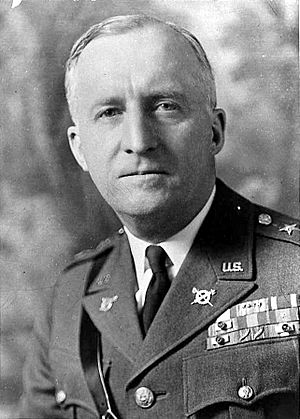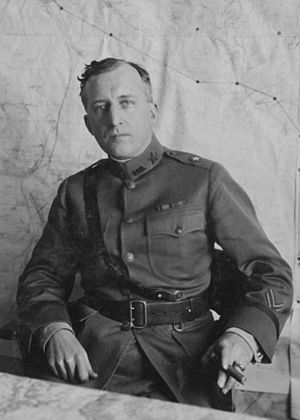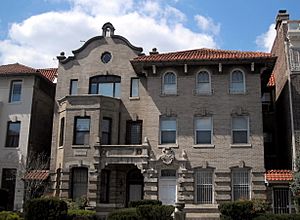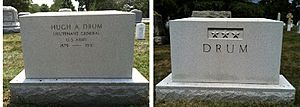Hugh Aloysius Drum facts for kids
Quick facts for kids
Hugh Aloysius Drum
|
|
|---|---|

Hugh Aloysius Drum
|
|
| Born | September 19, 1879 Fort Brady, Chippewa County, Michigan, US |
| Died | October 3, 1951 (aged 72) New York City, US |
| Buried | |
| Allegiance | United States |
| Service/ |
United States Army |
| Years of service | 1898–1943 |
| Rank | Lieutenant General (Army) Lieutenant General (New York Guard) General (New York Guard, retired) |
| Service number | 0-89 |
| Unit | U.S. Army Infantry Branch |
| Commands held | New York Guard Eastern Defense Command Second Corps Area First United States Army Hawaiian Department Fifth Corps Area 1st Infantry Division 1st Infantry Brigade United States Army Command and General Staff College |
| Battles/wars | Philippine–American War Veracruz Expedition Pancho Villa Expedition World War I World War II |
| Awards | Army Distinguished Service Medal (2) Silver Star |
| Alma mater | Boston College (Bachelor of Arts, 1921) |
| Spouse(s) | Mary Reaume (m. 1903–1951, his death) |
| Other work | President, Empire State Inc. |
Hugh Aloysius Drum (born September 19, 1879 – died October 3, 1951) was an important officer in the United States Army. He served in both World War I and World War II. He reached the high rank of lieutenant general. Drum was especially known for being the chief of staff for the First United States Army during World War I. He also commanded the First Army when World War II first began.
Meet Hugh Drum: An Army Leader
Hugh Drum was born on September 19, 1879, at Fort Brady in Chippewa County, Michigan. His father, John Drum, was also a career army officer. Sadly, his father was killed in Cuba during the Spanish–American War in 1898.
Early Life and Joining the Army
Hugh went to Xavier High School in New York City. After high school, he started studying at Boston College. When his father died, Hugh was offered a special chance to join the Army right away. He became a second lieutenant in the Infantry on September 9, 1898. He later earned his college degree from Boston College in 1921.
Starting His Military Journey
Drum joined the Army during a busy time, with conflicts like the Philippine–American War happening. He served in the Philippines with the 12th and 25th Infantry Regiments. He showed great bravery in the Battle of Bayan in 1899. For his actions, he received the Silver Citation Star, which later became the Silver Star medal.
He continued to learn and grow in the Army. He completed special training at the School of the Line in 1911. He also graduated from the United States Army Command and General Staff College in 1912. Later, he even taught there. Drum also took part in smaller military actions. These included the Veracruz Expedition in 1914 and the Pancho Villa Expedition in 1915-1916.
World War I Heroics
During World War I, Hugh Drum became a very important leader. He was chosen by Major General John J. Pershing to be an assistant chief of staff for the First United States Army. In 1918, he was promoted to colonel. He then became the First Army's chief of staff.
Drum was in charge of planning for two major attacks: the St. Mihiel and Meuse-Argonne offensives. These were huge operations that helped the Allies win the war. For his excellent work, he was promoted to temporary brigadier general. He also received the Army Distinguished Service Medal and awards from other countries.
Between the World Wars: A Busy Career
After World War I, Drum continued to hold important positions. He directed training and led the Command and General Staff College. He taught a new way of fighting called "open warfare." This method focused on quick movements and accurate shooting, rather than just direct attacks.
Drum also worked at the War Department in Washington, D.C.. He had disagreements with General Billy Mitchell about the future of the Army's air force. Drum believed the air force should stay part of the Army, and he successfully argued for this.
He commanded the 1st Infantry Division twice between 1926 and 1930. In 1930, he became the Inspector General of the US Army. He was promoted to major general at this time. From 1931, he commanded the Fifth Corps Area.
In 1933, Drum became the deputy to the Army's Chief of Staff, Douglas MacArthur. He helped decide how many planes the Army Air Corps should have. He also worked to keep the air force from becoming a separate branch of the military.
Drum was considered for Army Chief of Staff in 1935 and again in 1939. However, the position went to Malin Craig and then George Marshall. Even though he wasn't chosen for the top job, Drum was still highly respected. He was promoted to lieutenant general in August 1939.
World War II and Retirement
When World War II began, Drum was given command of the Eastern Defense Command. This meant he was in charge of protecting the Atlantic coast of the United States. In 1941, during a large training exercise called the Carolina Maneuvers, Drum commanded the First Army. He was briefly "captured" by enemy troops during the exercise. While the rules allowed him to continue, this event made some leaders wonder if he was ready for a major field command in modern warfare.
Drum retired from the Army in September 1943 when he reached the mandatory retirement age of 64. He received a second Army Distinguished Service Medal for his long and dedicated service.
Life After the Army
After retiring from the U.S. Army, Drum continued to serve. He became the commander of the New York Guard from 1943 to 1948. The New York Guard took on many important tasks during the war, like protecting key buildings. When he retired from the New York Guard in 1948, Governor Thomas E. Dewey promoted him to general (four stars) on the retired list.
From 1944 until his death, Drum was also the president of Empire State, Inc. This company managed the famous Empire State Building in New York City.
Hugh Drum passed away in New York City on October 3, 1951. His funeral was held at St. Patrick's Cathedral. He was buried at Arlington National Cemetery, a special place where many military heroes are laid to rest.
Family Life
In 1903, Hugh Drum married Mary Reaume. They had one daughter, Anna Carroll Drum, who was nicknamed "Peaches." She later married an Army officer named Thomas H. Johnson Jr.
His Legacy and Honors
Hugh Drum's papers, including his letters and diaries, are kept at the U.S. Army Heritage and Education Center in Carlisle, Pennsylvania. These documents help people learn about his life and military career.
In 1951, an Army training site in New York was renamed Camp Drum in his honor. Today, it is known as Fort Drum and is home to the Army's 10th Mountain Division.
Drum received many awards and honors throughout his life.
United States Military Awards
- Army Distinguished Service Medal (with an oak leaf cluster, meaning he received it twice)
- Silver Star
- Spanish War Service Medal
- Philippine Campaign Medal
- Mexican Border Service Medal
- World War I Victory Medal
- Army of Occupation of Germany Medal
- American Defense Service Medal
- American Campaign Medal
- World War II Victory Medal
- Conspicuous Service Cross (from New York State)
Foreign Awards
He also received honors from other countries, including:
- French Croix de Guerre
- French Legion of Honor (Commander)
- Belgium's Order of the Crown (Commander)
- Italy's Order of the Crown
Other Recognitions
- In 1931, he was inducted into the Xavier High School Hall of Fame.
- In 1940, he received the Laetare Medal from the University of Notre Dame. This award recognizes people who have contributed to the goals of the Roman Catholic church.
- He also received honorary degrees from many universities, including Boston College, Columbia University, and Georgetown University.
Dates of Rank
Here is a list of the ranks Hugh Drum held during his military career:
| No insignia in 1898 | Second lieutenant, Regular Army: September 9, 1898 |
| First lieutenant, Regular Army: January 15, 1900 | |
| Captain, Regular Army: March 23, 1906 | |
| Major, Regular Army: May 15, 1917 | |
| Lieutenant colonel, National Army: August 5, 1917 | |
| Colonel, National Army: July 30, 1918 | |
| Brigadier general, National Army: October 1, 1918 Reverted to permanent rank of major on July 31, 1919. |
|
| Major, Regular Army: July 31, 1919 Date of rank May 25, 1917. |
|
| Lieutenant colonel, Regular Army: July 1, 1920 | |
| Brigadier general, Regular Army: September 21, 1920 | |
| Lieutenant colonel, Regular Army: March 4, 1921 | |
| Colonel, Regular Army: May 9, 1921 | |
| Brigadier general, Regular Army: December 6, 1922 | |
| Major general, Temporary: January 29, 1930 | |
| Major general, Regular Army: December 1, 1931 | |
| Lieutenant general, Temporary: August 5, 1939 | |
| Lieutenant general, Retired List: October 16, 1943 | |
| Lieutenant general, New York Guard: October 19, 1943 | |
| General, New York Guard (Retired): September 30, 1948 |





